Microsoft expanded the use of add-ins for Outlook 2016 for Mac, according to. Add-ins are applications that work within the Outlook 2016 for Mac e-mail and calendar solution. They're made by Microsoft, such as the Wunderlist and Dynamics 365 add-ins, as well as other software vendors, such as Evernote and PayPal. There's even a that lets IT pros convert e-mails into help-desk tickets.
View the Microsoft Support Lifecycle information for Outlook 2016 for Mac For more information on the different versions of Office for Mac, see the Deployment guide for Office for Mac. Outlook for Mac 2011.
Microsoft first announced the add-in capability in September for Outlook 2016 for Mac users. It was described as a 'preview' back then. Today, Microsoft indicated that add-in access was expanded to other Outlook for Mac users, plus Office 365 and Outlook.com users. 'We are now making add-ins available to all Outlook 2016 for Mac customers who have Exchange 2013 Service Pack 1 or higher, or Office 365 or Outlook.com mailboxes,' Microsoft's announcement stated.
Presumably, the add-ins capability is no longer at the preview stage, since add-in applications are more broadly available in.
Configure Outlook 2016 1. Open Outlook 2016 and select Tools >> Add Account. • If this is your first time opening Outlook 2016, select Add Account and then Other Email from the account type menu.
Select Other Email from the account types menu. Enter your email info into the form and click Add Account. • Enter the email address that you're connecting to and it's associated password.
If you don't know your email password, can help you reset it. • Your user name is your full email address. • Select POP3 or IMAP. We recommend IMAP. • Enter in the Incoming mail (POP3, IMAP) server field.
It is advised that you also select 'Use SSL to connect'. This is a much more secure connection type. • Enter in the Outgoing mail (SMTP) server field. It is advised that you also select 'Use SSL to connect'. This is a much more secure connection type. Your email account should now be available for use in Outlook 2016. Please keep in mind that Outlook may takes several minutes to sync if you already have a large amount of mail on the server.
Figure 4: Enter your email account information in this window. • Enter Your Name as you want it to appear. • Enter your full email address username@example.com in the Email address: field. • Select POP3 or IMAP. We recommend IMAP.
• Enter in the Incoming mail (POP3, IMAP) server: field. • Enter in the Outgoing mail (SMTP) server: field. To avoid common authentication issues with Outlook, we strongly advise using SSL and port 465 for SMTP connections. • Enter mail.example.com in the Incoming mail (POP3, IMAP) server: field. • Enter mail.example.com in the Outgoing mail (SMTP) server: field.
To avoid common authentication issues with Outlook, we strongly advise using SSL and port 465 for SMTP connections. • Enter your full email address, username@example.com, in the User Name field.
• Enter your email password in the Password: field. TIP: If you experience any difficulty with the default outgoing SMTP Port 25, you can check the box Override default port and enter 587 or an alternate port you enabled. We also strongly recommend using SMTP and port 465 with Outlook.
For more information, please see: • Next, we'll configure your Outgoing server settings. Click on the More Options.
For Authentication, select Use Incoming Server Info. To avoid common authentication issues with Outlook, we strongly advise using SSL and port 465 for SMTP connections. Click OK to save your settings.
Configure Outlook 2010 1. Open Outlook 2010. Click File, then Add Account. See Figure 1 below. Figure 1: Click the '+Add Account' button to begin.
Microsoft Outlook For Mac Mojave

Enter your full email address and password. Outlook should automatically configure your account for you. If not, proceed to the next section.
Manually configure Outlook 2010 1. Open Outlook 2010. Click File, then Add Account. See Figure 1 below. Figure 1: Click the '+Add Account' button to begin.
Next, select Manually configure server settings or additional server types, then click Next. See Figure 2 below. Figure 2: This will allow you to enter your account information.
Apple may provide or recommend responses as a possible solution based on the information provided; every potential issue may involve several factors not detailed in the conversations captured in an electronic forum and Apple can therefore provide no guarantee as to the efficacy of any proposed solutions on the community forums. Apple Footer • This site contains user submitted content, comments and opinions and is for informational purposes only. Skype for mac os x 10.2 virtualbox.
Free Outlook For Mac
In this screen, choose Internet E-mail, then click Next. Figure 3 below illustrates this window. Figure 3: Be sure to select 'Internet E-mail' then click the 'Next' button. This window is where you enter your email information, see Figure 4 below. Figure 4: Enter your email account information in this window. • Enter Your Name as you want it to appear. • Enter your full email address username@example.com in the Email address: field.